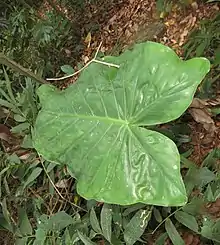| Alocasia fornicata | |
|---|---|
 | |
 | |
| Scientific classification | |
| Kingdom: | Plantae |
| Clade: | Tracheophytes |
| Clade: | Angiosperms |
| Clade: | Monocots |
| Order: | Alismatales |
| Family: | Araceae |
| Genus: | Alocasia |
| Species: | A. fornicata |
| Binomial name | |
| Alocasia fornicata (Kunth) Schott | |
| Synonyms[1] | |
|
Colocasia fornicata Kunth | |
Alocasia fornicata is a plant species of many-nerved, broad-leaved, rhizomatous or tuberous perennials from the family Araceae, native to Indochina and to the Indian Subcontinent.[1] It characteristically grows 2' - 3 ' in height with slightly pink petiole, triangular wide shaped leaves and a horizontally growing stolon.[2][3][4][5]
The plant's spadix is collected and cooked in North East Indian states of Mizoram, Manipur and Tripura where the plant is known locally as Baibing in Mizo. Alocasia affinis is also consumed. Both are a much favored seasonal vegetable.
The plant, including the spadix, contains needle-shaped crystals of calcium oxalate known as raphides that are believed to be a defense mechanism against plant predators[6] that can tear and damage the mucus membranes of the throat or esophagus.[7]
References
- 1 2 Kew World Checklist of Selected Plant Families
- ↑ Ara, H. (2001). An Annotated Checklist of Aroids of Bangladesh. Bangladesh Journal of Plant Taxonomy 8(2): 19-34.
- ↑ Govaerts, R. & Frodin, D.G. (2002). World Checklist and Bibliography of Araceae (and Acoraceae): 1-560. The Board of Trustees of the Royal Botanic Gardens, Kew.
- ↑ Boyce, P.C., Sookchaloem, D., Hetterscheid, W.L.A., Gusman, G., Jacobsen, N., Idei, T. & Nguyen, V.D. (2012). Flora of Thailand 11(2): 101-325. The Forest Herbarium, National Park, Wildlife and Plant Conservation Department, Bangkok.
- ↑ Choudhary, R.K., Srivastava, R.C., Das, A.K. & Lee, J. (2012). Floristic diversity assessment and vegetation analysis of Upper Siang district of eastern Himalaya in North East India. Korean Journal of Plant Taxonomy 42: 222-246.
- ↑ Arnott, H.J., M.A, Webb (2000). Twinned Raphides of Calcium Oxalate in Grape (Vitis): Implications for Crystal Stability and Function. International Journal of Plant Sciences 161(1):133–142.
- ↑ Outbreak of Food-borne Illness Associated with Plant Material Containing Raphides. Informa Healthcare.